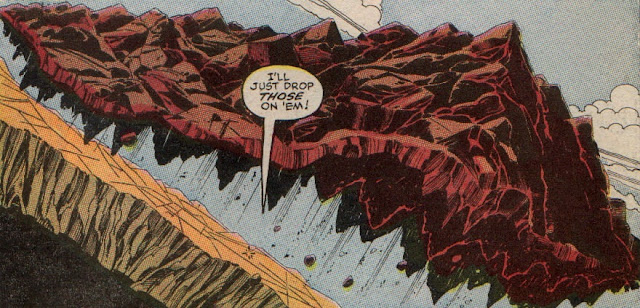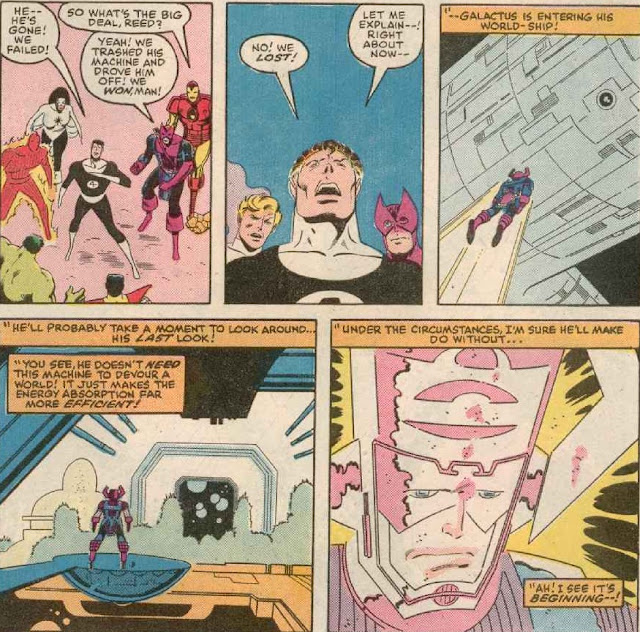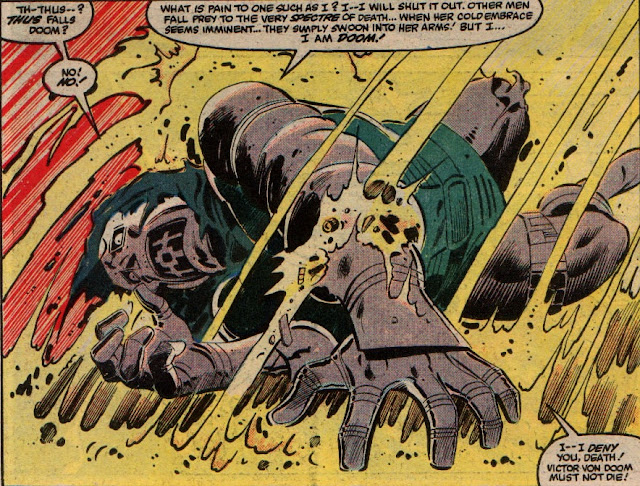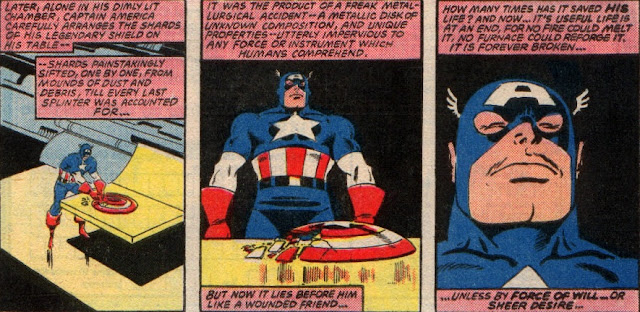I'll say this right away, I'm not as good with the Marvel Universe as I am with the DC Universe. DC is my neighborhood, it's where I live--up until the reboot, it still managed to keep that comfortable feeling and I always felt properly oriented. But that doesn't mean I hate Marvel. Quite the contrary, when I was a kid and just starting reading comics, most of the comics I read were Marvel stuff. While that was because my dad was buying the comics, and I was kinda beholden to his tastes . . . Marvel Comics were at what I still believe to be their creative zenith. At this period, just about every single Marvel Comic on the stands were incredible in one way or another. Heck, people who have been reading comic books as long as I have--or longer--still point to various stories from Marvel in the mid-to-late 70s to the mid-to-late 80s as being some of if not the best superhero comics ever told. It's not that good comics didn't come out before or after, or that there aren't any better comics. Don't be ridiculous. It's just that there was such a concentration of really freakin' good superhero comics at the time, it's remembered really fondly by a lot of people. In my opinion, Marvel Comics as a whole has never been better. Sure, individual series may have reached higher points at other times, but as a whole? Mid-70s to late 80s Marvel. Which brings us to one of those comics from around that time period. Secret Wars by Jim Shooter and various artists.
Jim Shooter was editor-in-chief of Marvel at the time, and at least part of the reason Marvel was hitting such strides, but his editorial practices tended to anger and alienate the people working for him. We're not here to talk about that, though, we're here to talk about the people and anthropomorphic personifications of weird stuff that would inhabit a comic book universe. Meditations on godhood and the nature of godhood . . . with people punching nine kinds of death at each other.
COMIC BOOKS!
Anyway, in the mid-80s, DC was ramping up for something big, something special, a massive cross-over limited series that would include EVERY character they owned, maybe for the first time, even if only for a panel or two. It would be called Crisis On Infinite Earths and would have the tagline "Worlds will live! Worlds will die! And nothing will ever be the same!" For better or worse, it did manage to live up to that, but before it came out, there were rumors in the industry that this was gonna be a big thing. So Marvel heard about it, and decided to swoop in and do it first.
COMIC BOOKS!
Anyway, I didn't know about any of this at the time--I wouldn't read Crisis for years, in fact--I was just a kid seeing all sorts of super hero characters meeting up and fighting. That was all I cared about, and sometimes that's still all I need. I can be as easily amused as anyone. So in all sorts of Marvel Comics of the time, various characters--Spider-Man, X-Men, Avengers, the Wrecking Crew, Galactus, etc--were curiously drawn to these weird doorways. Some of them entered the door, and were transported elsewhere.
That was the good guy elsewhere (good guys and Magneto). There was a bad guy elsewhere floating not far away. The Wrecking Crew, the Enchantress, Doctor Octopus, the Lizard, the Absorbing Man, Molecule Man, Ultron, Kang, and Doctor Doom were there, and we'll get to them in a second.
The entire universe it seems, is completely erased, except for the two groups of supers, and a planet cobbled together out of various other worlds. The bad guys are kind of violently upset by this, so Doctor Doom manipulates Molecule Man into tossing Ultron at Galactus, and if you even know half of those names, you know that bad times are here for Ultron. But don't worry, he's a robot so he'll get better.
COMIC BOOKS!
Once Ultron is off the board, the players get a message.
Immediately, Galactus swoops out and demands that the Beyonder make good on his promise to . . . grant wishes . . . and remove his all-encompassing hunger. Doctor Doom follows, because if there is power to be had, Doom will have it. However--
Uh, one of them is an anthropomorphic embodiment of cosmic hunger, and the other is Doctor Doom, so they'll be fine.
COMIC BOOKS!
So, anyway! That basically begins The Secret Wars, and for the full twelve issues, all sorts of things happen. You can pick up the trade collection of the series to find out all the intricacies of the plot . . . I'm sorry, I couldn't finish that without busting out laughing. The plot is basically this: the good guys and the bad guys fight, and Doctor Doom schemes for power. There's a little bit more to it--this is the story where Spider-Man gets his black outfit, for instance--but really, it's just an excuse for fighting. Why?
COMIC BOOKS!
The point of bringing all of this up is that this is a 12 issue story,
and in those twelve issues, all sorts of really cool stuff happens. Like
Spider-Man humiliating all the X-Men who came with.
Of course, Professor X just makes him forget with his psychic powers, but that's still pretty freakin' awesome.
Then a little bit later, the Molecule Man, stretching out his powers, notices a mountain range in the distance, and figures out a seemingly simple way to defeat the heroes! He lifts the mountain range--yeah the MOUNTAIN RANGE!!--and:
But don't fret. Remember, this is--
COMIC BOOKS!
The heroes survived. How? Well, if you were reading the comics as they came out, the cover spoiled it.
That's right, the Hulk. In possibly one of his most incredible feats of strength, at least to date, he grabbed the mountain range and HELD IT UP, preventing it from crushing the heroes. A little jury-rigging of various bits of hero-tech by Reed Richards later, and they blast a hole in the mountainside, freeing themselves.
And then they have to fight Galactus. To prevent him from converting the planet they're on to energy--it's how he feeds--they team up to try to stop them. But before they do that, more Spider-Man showing off.
You see, the various planets that were cobbled together to create the world their on included a suburb of Denver, Colorado, in the United States. From this suburb came the second Spider-Woman (who eventually became Arachne and also the second Madame Web) and two ladies Doctor Doom gave super-powers to. One, Volcana, became Molecule Man's love interest for a while before sort of disappearing. These things happen. The OTHER, however, became the second Titania, a longtime rival of She-Hulk. You see, she snuck up on Shulkie and wallopped her a good one with some heavy sci-fi furniture, knocking her out. Then later, she ganged up on her with the Wrecking Crew, and beat poor Shulkie pretty bad. When the heroes came to rescue her, Titania faced Spider-Man, and while She-Hulk is a qualified hero and good at what she does, so is Spidey . . . and Spidey's been doing this since he was 15 years old.
This one encounter gave Titania aracnophobia (not just of Spider-Man), and an inferiority complex with regards to him for years.
The upshot of the battle is that the heroes ultimately defeat everyone who was on board the "bad guy" ship at the beginning . . . except Galactus.
So, yeah. Remember I mentioned "bad times are here for Ultron"? So yeah, now the heroes have arrived at the bad times. Because Galactus is, essentially, a living, intelligent black hole that can control everything but his need to consume. And if the implications of that doesn't scare the everlasting gobstopper out of you, be blissful in your ignorance.
Reed Richards realizes that, if Galactus were to win the contest the Beyonder set out for them, or were ultimately defeated by the Beyonder, the universe would be better off . . . (this was before it was revealed that if Galactus ever lost his hunger, it would just go to someone else, someone potentially worse). So Galactus hears Reed explaining this to the other heroes, and . . .
They have a little talk.
Meanwhile, Doom, after failing yet again to gain more power, and wallowing in his thoughts for several issues, reaches an epiphany and escapes from the holding cells the heroes put him and the other villains. He also frees a guy named Klaw with sonic and energy manipulation powers that he found on Galactus' ship and liberated a while ago, creating a very grateful and weaselly aide. And then proceeds to dissect him, which Klaw is perfectly fine with.
And then Reed is returned to the heroes and has had a change of heart about fighting Galactus.
Unfortunately, the baby didn't survive childbirth . . .
. . . uh, COMIC BOOKS!
Anyway, the heroes fight Galactus, and manage to beat him into a retreat! But all is not as it seems, as Reed explains:
Galactus is actually devouring his own world for the energy. After that, he'll be at full power, and ready to devour the planet, as well, so that he'll have some extra power in case he needs to take on the Beyonder. So . . . everybody's doomed.
But nobody is counting on being Doomed.
Which leads to quite possibly the most memorable cover that has--I think--never been subject to an homage.
So Doom has stolen the energy from Galactus into himself, and he uses this power to go head on, one-on-one, against the Beyonder.
Let me make this clear: the Beyonder is the equivalent of God. Not like 'ho ho fun" God, either. Old Testament God. And he's already beaten back Galactus (and Doom) "like flies" once in this very story. But that's not gonna stop Doom. He even smack talks the Beyonder when he attacks him!
For his effrontery, he gets an arm and a leg lopped from his body.
Oh, man I sometimes forget how gruesome comics can be. Uh . . . yeah, fighting off an omnipotent being alone is possibly not the greatest idea Victor's ever had . . .
In fact, he even tries to get the heroes (and Magneto) to join with him so that he can finish off the Beyonder. Although Magneto almost accepts--almost--the ploy doesn't work. It's just Victor von Doom versus the Beyonder.
But . . . here's the amazing thing.
He actually won.
He is also very pretty.
Now, I don't wanna give EVERYTHING away. Just . . . just one more thing.
At one point, Captain America's unbreakable shield is broken.
However, due to all of the things that happened in the story, a
situation arises where the planet is basically bombarded with "wish
fullfilment" energy that seems to respond to strong desire, or strong
will. Stuff like Curt Conners being cured and the little dragon Lockheed
getting a friend, or Ben Grimm being able to control his transformation
into the Thing . . . or Reed Richards performing a punch of experiments
really well . . .
COMIC BOOKS!
And so Steve Rogers decides to take advantage of the situation--
--to fix his shield. That is both amazingly dorky and incredibly cool at the same time.
Anyway, Secret Wars isn't as well remembered as Crisis on Infinite Earths, partly because many of the things that got changed were relatively unimportant or reversed fairly quickly, whereas the same cannot be said of the things Crisis changed. Maybe we'll get to them one day. But that doesn't change that Secret Wars still had lots of awesome things going on, and is worth at least one read-through. It's available in trade, and you can pick it up on Amazon, so there. It had a sequel, Secret Wars II, that is even less well remembered (for good reason), and the terms "Secret War" or "Secret Warriors" shows up on occasion at Marvel. But they all had their start here.
Aaron "The Mad Whitaker" Bourque; maybe the issue cover never gets an homage because . . . it's kinda gross?

























No comments:
Post a Comment